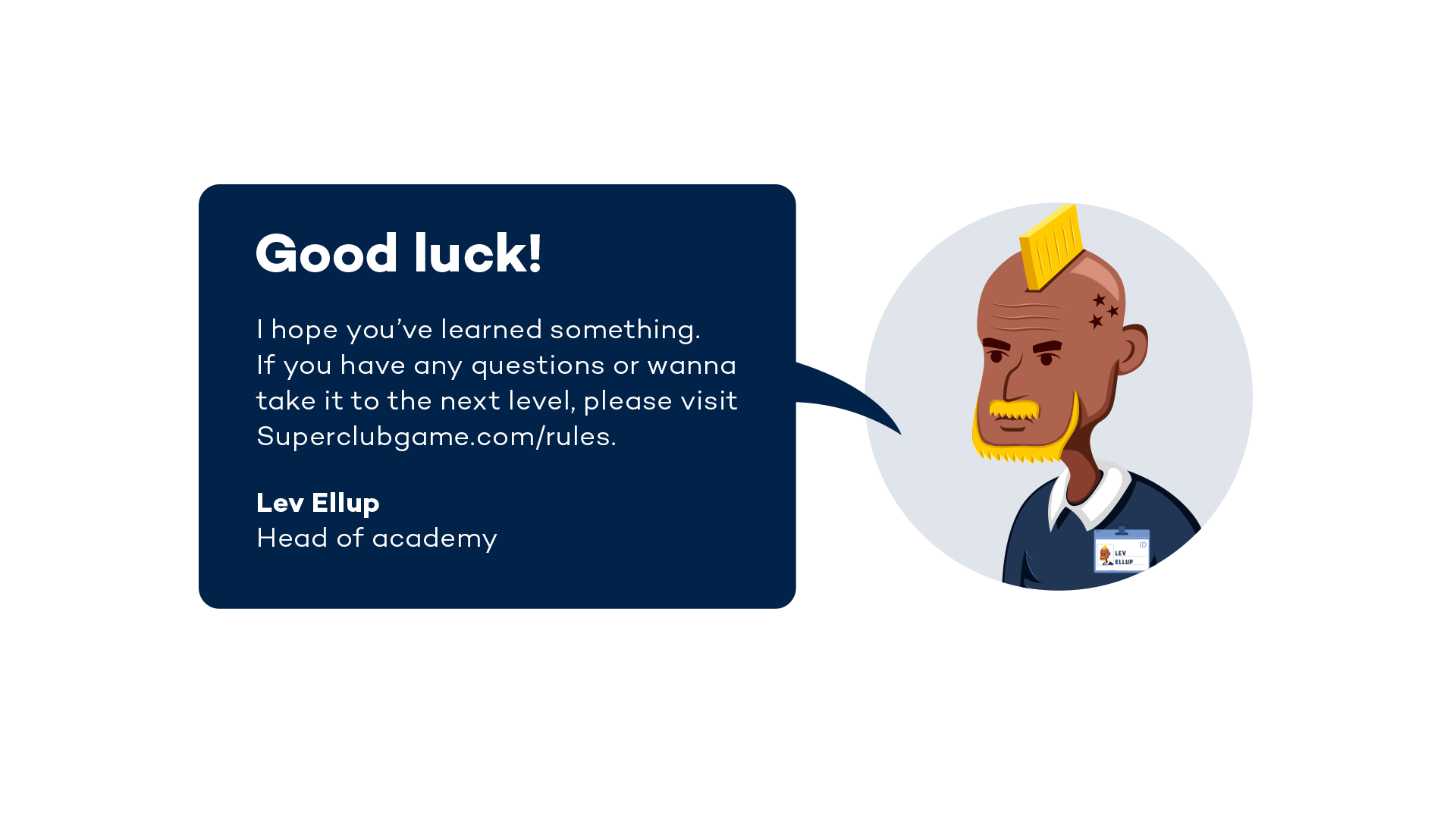Superclub rules
As a football manager, you'll need to make all the tough decisions: from picking your starting lineup to managing your finances and signing new players. You can read up on the Superclub rules below or download a PDF pack containing English, Spanish, German, French, Italian and Portuguese versions of the rules.
Download PDF 🇬🇧🇩🇪🇪🇸🇮🇹🇵🇹🇫🇷
Game boards
This is the main game board. Big and green and goes in the middle. The blue board is two-sided. Use the draft side to start, then flip to The World of Football after the draft.

Player cards
The most important cards. Come in 5 categories: green attackers, yellow midfielders, red defenders, light red goalkeepers and purple utility players. Ability from 1 to 6 stars. Some have empty stars that indicate potential. Some have chemistry stars that can combine for added ability.

Game changer cards
Contain events that can be positive or negative. You get Game changer cards during matches.

Key staff cards
Gives different bonuses. You can hire Key staff in step 4 of the off-season. Maximum 3 per team.

SuperCup cards
You get one of these cards when you win a season. Good luck beating London!

Developed player cards
When you train a player’s ability (fill in one or more of the empty stars), you’ll find the improved player in these decks.
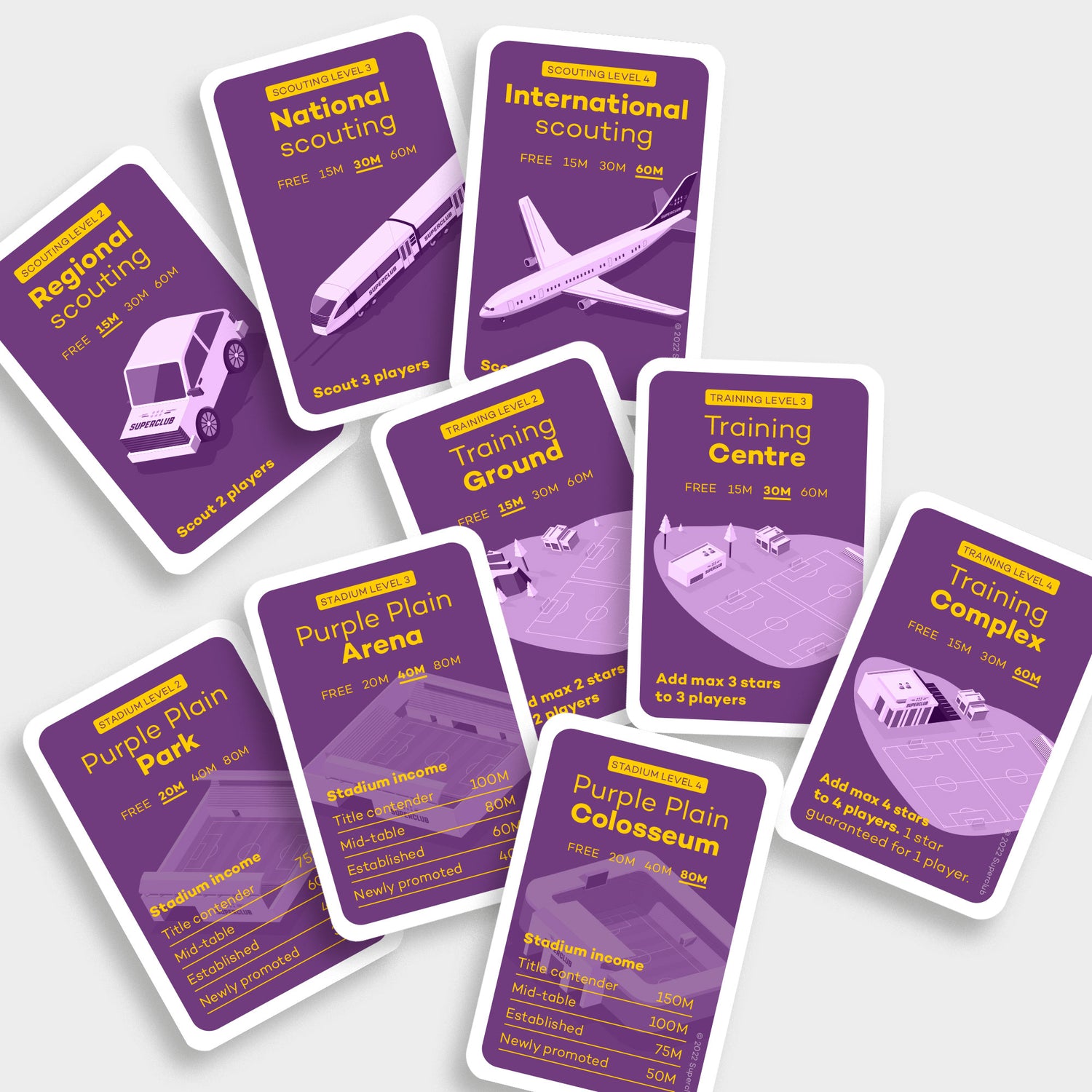
Investment cards
These can be bought in step 4 of the off-season. Improvements to training, scouting and stadium.
Other game elements

Captain boost
Use from season two and throughout the game. Shows league position (cross check with fixture list), placement reward that you receive after the season and boost in a desired third during matches.

Squad token
Count the number of full stars in your squad (just player cards – no default keeper, no bonuses from Key staff or Captain boost). Place your squad token on the corresponding number on the game board table.
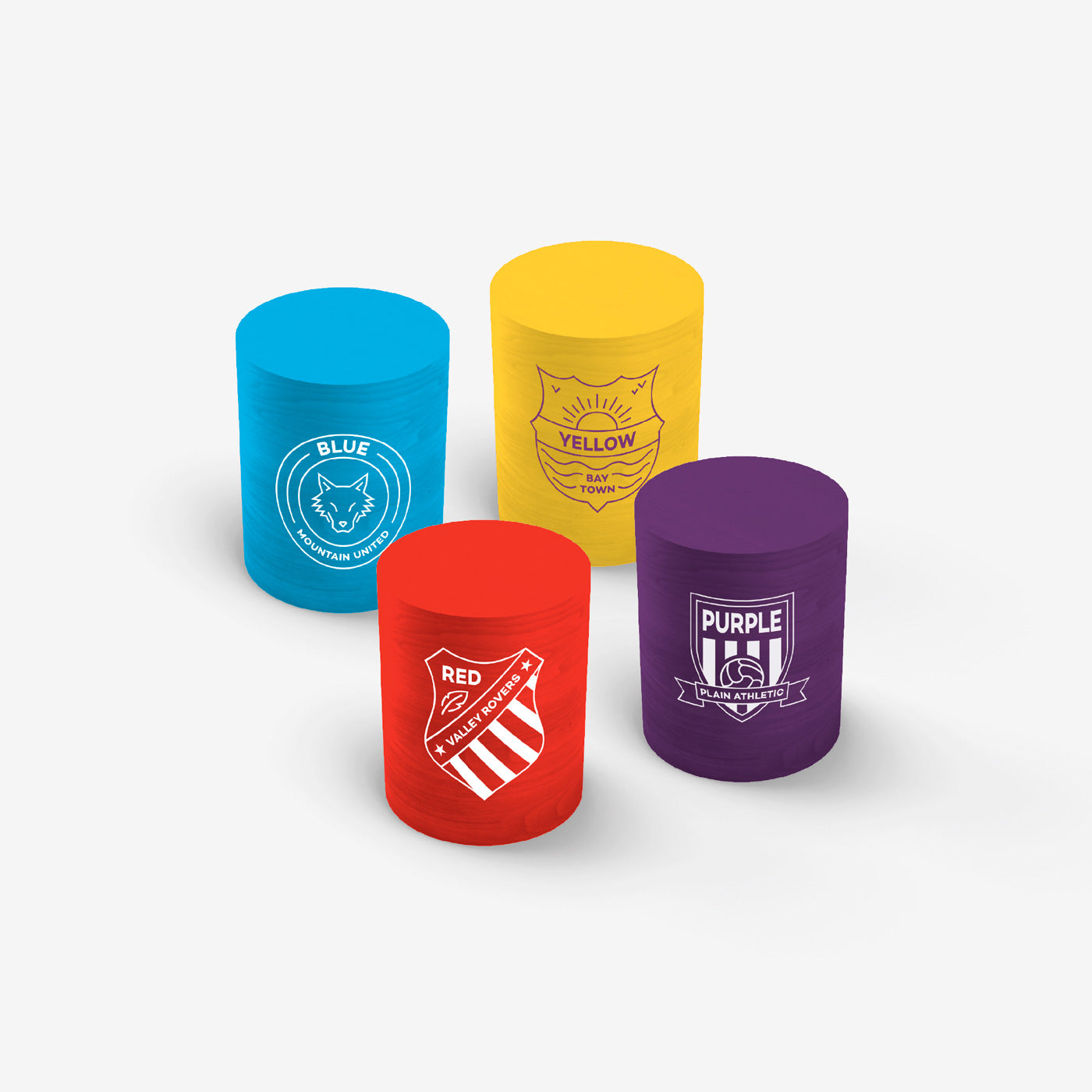
Point marker
Place on squad token at the start of the season. Move six places up the table for a win and two for a draw.
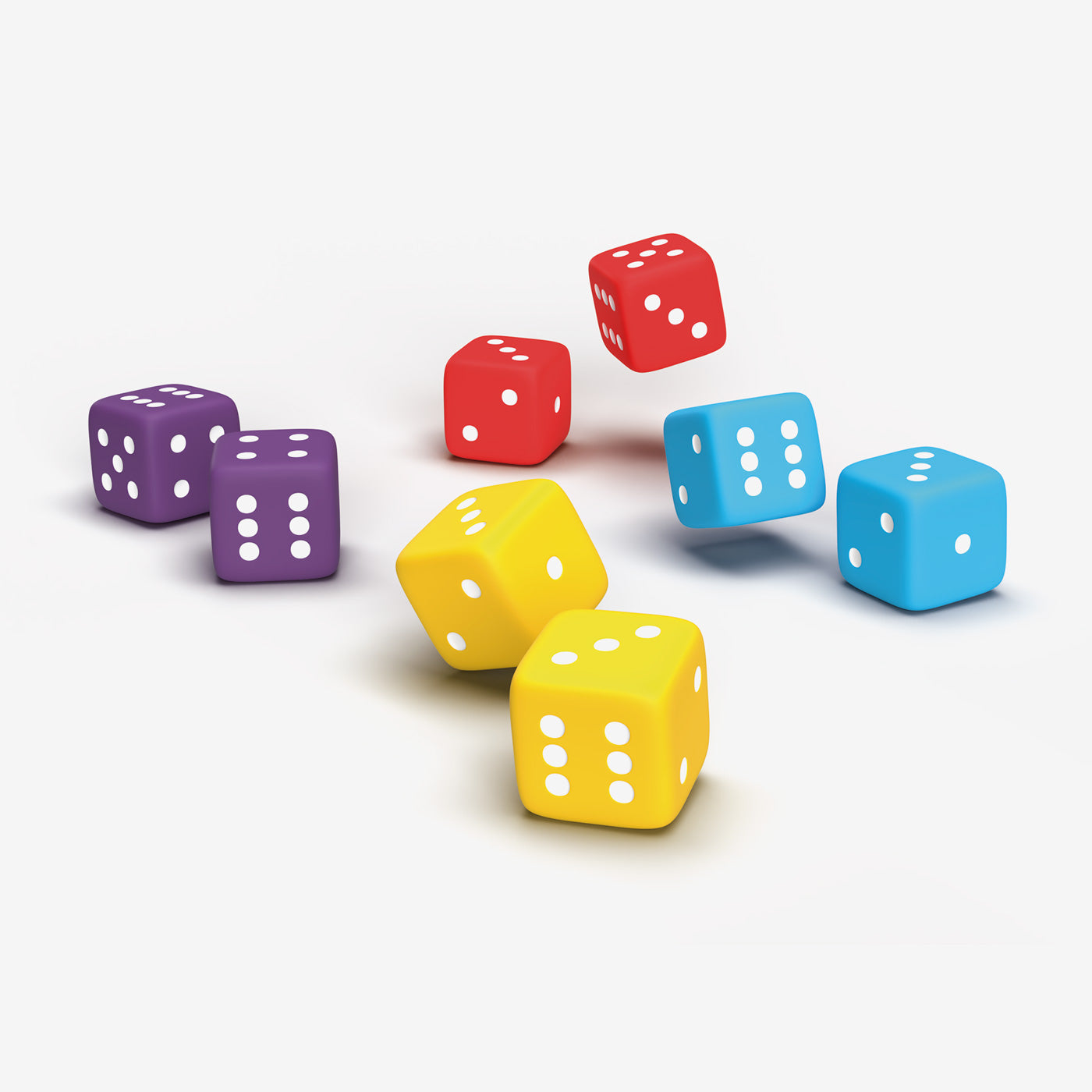
Dice
Six-sided dice in your team’s colors.When you roll one dice, every outcome is just as likely. Roll two dice – as you do in Superclub matches – and things change.

Two-dice probability:

Club pad
Where you place your training, scouting and stadium cards as you develop your club. It also has a place for your money.
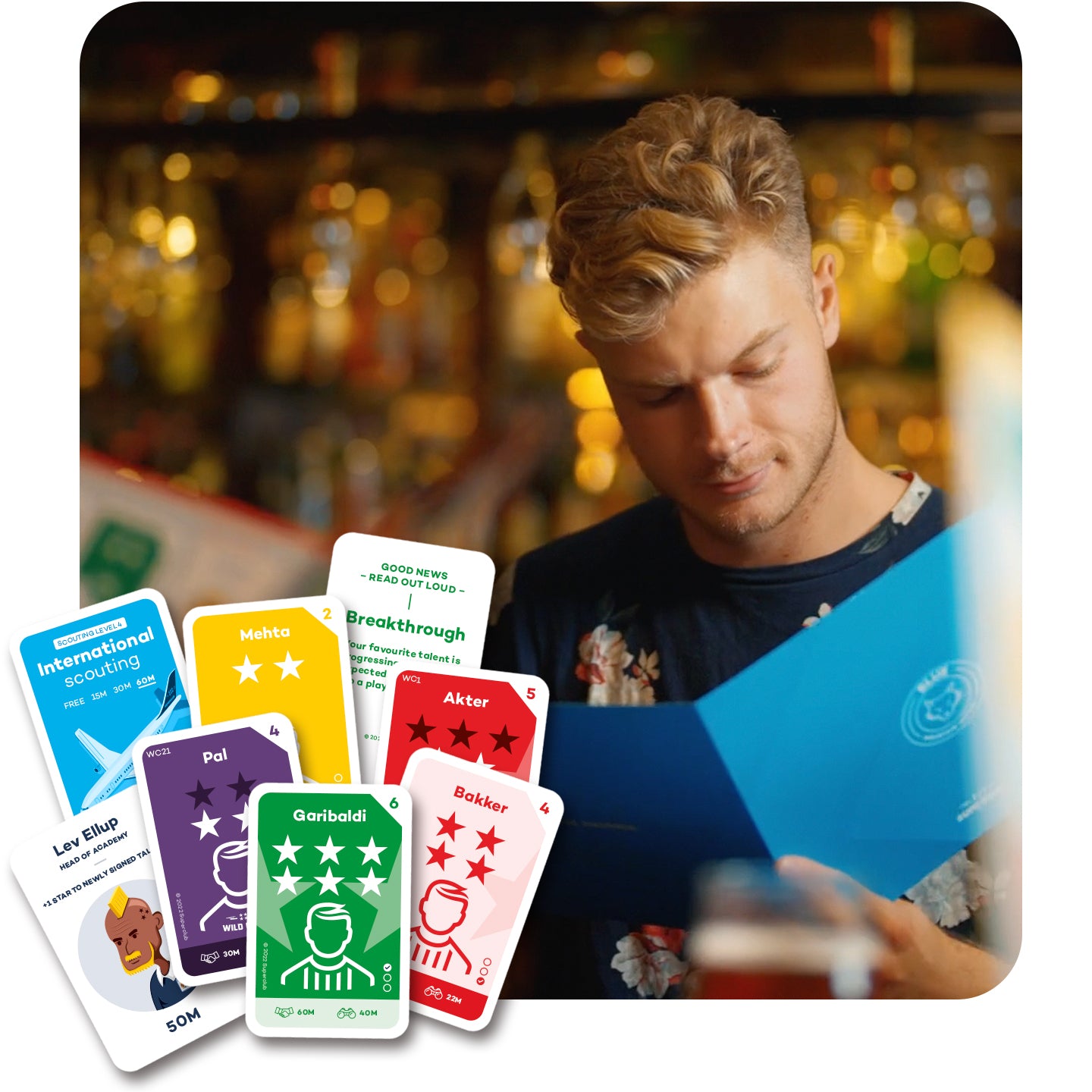
Manager folder
Where you set up your team, manage your squad and Key staff members. Note: Flip injured players! The card should be placed face down on the bench when a player is injured.
Superclub at a glance
The objective is to win the game by finishing the season with 100 points or win three seasons and the SuperCup.

Quick game
Start with +1 development levels (training, scouting, stadium) and 1 Key staff member (draw 2, keep 1). Two SuperCup cards are enough to play the SuperCup final. Place the blue draft board above the green game board.

Player draft
Roll one dice each to determine who will be manager 1 in the first season. Highest roll wins. The manager to the left of manager 1 is manager 2 etc. Place 16 players face up on the board. Go clockwise around the table picking one player each until the board is empty. Manager 1 starts the first round, manager 2 the second round etc. Repeat the process as many times as there are managers in the game so that every manager ends up with 16 players in their starting squad. After the draft, flip the board to discover The world of football.

Note! No Garibaldi in the draft. He’s too good to be drafted. If he comes up, simply replace him on the draft board with another player card from the deck. Once the draft is over and before the player cards are divided into continents, shuffle Garibaldi back into the deck.
Game pieces
Each manager has two game pieces, a squad token and a point marker. The squad token should always mark the total strength of your full squad, meaning the amount of stars on all your player cards combined (not including the Given goalkeeper, potential stars, chemistry, captain boost or key staff advantages, just full stars on player cards). Do this right after the draft and move it up and down the table as you strengthen or weaken your squad. If your squad is strengthened or weakened during the season (only happens with Game changer cards), both pieces must be moved up or down the table. The point marker is used in the season (see the Season section).
Off-season
Start the game with an off-season. This is where you improve all aspects of your club. Keep the manager folders open at all times during the off-season. Everyone should be able to see everyone else’s squad. The off-season has 5 steps.
1. Finance
Finance is easy in the first round. Just hand out the starting cash and begin playing. All other steps in the off-season are completed as normal in the first season.
Slower game: 90 million
Normal game: 120 million
Quicker game: 150 million
In the following seasons, the finance step becomes much more interesting with 4 actions.

a) Placement reward
The first thing you do after completing a season, is to hand the captain’s boost/placement card to the right manager. They state how much financial reward each manager will receive from their league position.
1st: 100M
2nd: 90M
3rd: 80M
4th: 70M
5th: 60M*
6th: 50M
**Only available with the Top Six expansion pack.

b) Stadium income
Crosscheck each manager’s stadium level (Field, Park, Arena or Colosseum) with their table status marked by the point marker piece at the end of the season (Newly promoted, Established, Mid-table or Title contender). Hand out stadium income.

c) Wages
You can’t make money without spending money, and maintaining a strong squad is not free. Pay 1M per star in your squad (including goalkeeper cards, but not the 1 star default goalkeeper Given), as marked by your squad token.
d) Buy unhappy players (optional pro-rule)
Your ability to keep your best players happy with your clubs progression, depends on your table status at the end of the season: Newly promoted (keep 3 star players happy), Established (keep 4 star players happy), Mid-table (keep 5 star players happy) or Title contender (keep all players happy).
If your point marker reaches a status level above one or more of your competitors, and they have a player that you could keep happy but they can’t, you can make a bid of 15M x full stars for that player.
The manager receiving a bid for his or her player must then decide to either a) sell the player for that amount, or b) try to negotiate better deal, or c) if negotiations fail, bench the player for the entire upcoming season as he refuses to play for the club. (“If you don’t give me 20M more, I don’t care. I’d rather bench Garibaldi than to give him away for 90M”).
Placing an unhappy player bid means that the player in question will not play for his current club in the upcoming season under any circumstance (he either stays and is unhappy or leaves). That means that somebody else will have to step up. The manager receiving the bid immediately gets to add one star to one optional player with potential, regardless of whether the unhappy player stays or goes.
Benching the player will retain his value to the squad (not affect the squad token), but he can not be used in matches.
If more than one manager can make an unhappy player bid, there are some limitations:
- a manager can only bid for one unhappy player per season.
- a manager can only be the target of one unhappy player bid per season.
- the season champion starts the bidding. Other managers who can make unhappy player bids must decide whether to enter this bidding round or stay out of it to bid for another player from another club.
Unhappy players will only join clubs that match their ambitions, so clubs without the necessary status level can not enter the bidding. All bids are binding.
2. Training
Each manager starts with the basic training facilities, a normal training pitch, giving you the opportunity to fill one hollow star for one of your players. Choose the player you want to develop and roll 1 dice. You need to roll at least the number eyes/dots that you want your player to reach. The champion goes first, and you continue clockwise around the table.
- Develop to 2 stars (roll 2 or higher)
- Develop to 3 stars (roll 3 or higher)
- Develop to 4 stars (roll 4 or higher)
- Develop to 5 stars (roll 5 or higher)
- Develop to 6 stars (roll 6)
As you upgrade your training, you gain the ability to develop multiple players by multiple stars every season, but the dice always decides how much your talents will develop (with the exception of the top level training complex, allowing you to give one player one star without rolling the dice. In this case, you must assign your guaranteed star before you start rolling).
Upgraded players are found in the Developed attackers/midfielders/defenders decks. The number in the top left corner on the player card shows where in the deck you find the upgraded player.
Example:
You’ve invested 30M in a nice Training Centre, giving you the opportunity to add up to 3 stars to each of 3 players cards. You choose to develop a player card with 2 full stars and 6 star potential.
- If you roll 1 eye, nothing happens – try again next season!
- If you roll 2 eyes, nothing happens – try again next season!
- If you roll 3 eyes, your player card is upgraded to 3 stars.
- If you roll 4 eyes, your player card is upgraded to 4 stars.
- If you roll 5 eyes, your player card is upgraded to 5 stars.
- If you roll 6 eyes, your player card is also upgraded to 5 stars.
(If you had the state of the art 60M Training Complex, your player card would have been maxed out with that one roll of the dice).

3. Scouting
Scouting is easy. Draw player(s) from your continent(s) of choice, and decide if you want to buy the player for the discounted scouting price in the bottom right corner (marked by binoculars). Unsigned players goes in the Inactive players pile. The champion goes first, and you continue clockwise around the table.
Each manager starts with the basic Local scouting, giving you the opportunity to scout one player in the first off-season. As you upgrade your scouting department, you will be able to scout multiple players per off-season later in the game.
4. Investments
It’s time to invest in the long term future of your club. The champion goes first, and you continue clockwise around the table. You have a maximum of two actions per season, and not in the same department. You’re not allowed to skip a step in the investments either. You can invest in training facilities, scouting department or stadium – and/or hire key staff.
The price of the investment is found near the top of the training, scouting or stadium card. Your current level is bold and underlined, and the price of the next investment is seen to the right.
Key staff: You can also use one of your investments to hire key staff. These come with a variety of advantages that lasts throughout the game. The price of hiring them is found at the bottom of the card. If you want to hire key staff, pick 2 cards and hire 1 or none. Even if you end up not hiring any of them, you still spend one investment action.

Key staff can’t be sold to the bank. You have to fire them without compensation if you wish to hire a new Key staff member. You can sell them to another manager if the two of you can agree on a deal.
5. Deadline Day
Managers are free to transfer players between each other at any point during the off-season after the finances have been completed. But it’s often difficult to get your opponents to agree to selling you a player you want. Not to worry! During every season, there are several (1 more than there are managers in your game) foreign players available for transfer on deadline day. The champion starts by turning one player from The world of football board. This player is now available and will go to the highest bidder in a free-for-all bidding war. The minimum price is shown in the bottom left corner, but the price often goes much higher as a result of intense bidding wars. If two managers have bid the same amount for a player and none of them are willing to go higher, the player will go to the one with the strongest squad.
When the player is either signed by a club or rejected by all, you continue clockwise around the table flipping players from the board. The champion starts and ends. Unsigned players goes in the Inactive players pile.
Note: You can have a maximum of 23 players in your squad (11 players on the field + all substitute slots filled will give you 23 players). At any point, you can sell players abroad (back to the deck) for their scouting price found in the lower right corner (binoculars). The bank then pays for the player. This means that you can effectively use players as currency – there’s no need to exchange player cards for money, then use the money for the desired transaction. Remember to move your squad token down the board as you weaken your squad.
Season
Once the pre-season is over, it’s time to play matches. Follow the schedule on the board as to who plays who at which stage of the season.

Player cards
Position: There are five kinds of players. Green are attackers, yellow are midfielders, red are defenders, light red are goalkeepers and purple are utility players (only in the Top Six expansion). Utility players can play in any position (except goalkeeper) without losing stars. Attackers, midfielders and defenders lose half a star for each third they move across (midfielders can play both attack or defence and only lose half a star, while an attacker deployed in defence will lose a whole star).

Potential: Some players have empty stars. This indicates their potential, which you can fulfill by training them in your training facilities (see player development).

Chemistry: Some players have a large tinted half star on the right side, the left side or on both sides. These players work extra well with certain other players. Combine one left and one right star in your line-up to gain one extra star in that third.

Pre-match
Before a match, set your team up in one of the five legal formations, hidden from your opponent. The legal formations (defence-midfield-attack, excluding goalkeeper) are:

From season 2 and onwards, also place the captain’s boost in your desired third. The boost card serves multiple purposes. It tells you which position you came in last season, to make it easy to follow the season schedule. It tells you how much money you get as a position reward and gives you a moral boost corresponding with your placement number in your desired third every match in the entire season. Great teams are known to bounce back, and this mechanism levels the playing field (1st place gives you 1 star extra in desired third, 2nd place 2 stars and so on). You can choose a new captain before every match. Once both managers are ready, reveal your line-ups.
Match
The matches are played in three thirds and start with midfield versus midfield. Count the full stars in each midfield line-up, add Captain boost, chemistry stars and key staff effects, throw 2 dice and add the scores together. The manager with the highest total (stars, boost, staff and dice eyes) wins the third.
The winner then goes on the offensive with their attack versus the opponent’s defence. In case of a midfield draw, the home side, as seen in the fixture list, goes on the attack first. Repeat the process described above.
PS. Goalkeeper stars count towards your defensive total.
If the same player has won both thirds, the game is over. You don’t play the last third. If it’s 1–1, or even 0.5–1.5 (a draw in one of the thirds), the last third is played to determine the winner (or seal the draw).
Points during the season are represented on the board by the Point marker (see page 6). Start from the base, and add points earned during the season.
Match points are as follows
Win: 6 points
Draw: 2 points
Lose: 0 points
Note: Matches are, whenever possible, played simultaneously. If you’d like a longer game, you can play home and away matches against each opponent (already recommended on the chart for heads up games). If you do this, then half the points awarded for each match: 3, 1, 0. In this case, follow the fixture list on the board until every match is played twice.
Simulated matches
There are 5 matches every season, giving the possibility of 30 points from matches. When playing fewer than 6 players, simulate the remaining matches as instructed in the fixture list on the board.
To simulate a game, simply roll two dice. The strength of your squad (squad token) determine how likely you are to win a simulated match. You can see what you need to roll to win on the board to the right of the table under SIM-roll. After the simulation, use the point marker to mark these points on the board as you would after a normal match.
There are no Game changers or injuries in simulated matches.
Injuries and Game changers
If you roll double dice (two equal) (1+1, 2+2, 3+3 etc.) you either get an injury or a Game changers card.

Injury
Counting from the left in your line up, if you have a player in the slot corresponding with the number on the equal dice, (1+1 is the leftmost player, 2+2 is the second leftmost player etc.), that player is injured for the rest of the season. Move the player card to the bench and face it the other way, and bring on a substitute from the bench. The substitute’s stars count in the match. Injuries do not affect squad strenght.

Game changers
Counting from the left in your line up, if you don’t have a player in the slot corresponding with the number on the double dice (two equal), you get a Game changer card. Save it until after the match is over – then read it out loud if required or save it for a match of your choosing if it’s a tactical Game changer that says “Play when needed”.

End of season
Once the season is finished, the manager with his or her point marker piece on the highest number, is the champion. The point marker also shows what status level each club has in the upcoming off-season, determining stadium income (and who can bid for what player if you play with the optional “Buy unhappy players rule”). The squad token serves no function here, except as the starting point for next season (although that’s likely to improve during the off-season) and how much money to pay in wages.

In case of two or more teams ending up with the same amount of points, simply roll one dice each to determine the order. The champion gets to draw one SuperCup card. Do NOT look at the SuperCup card! Hand the captain’s boost over to their new owners according to table position and repeat all the stages of the off-season, unless there is a winner with 100 points or a manager with three or more SuperCup cards who can decide whether or not to play the SuperCup.

Do we have a winner?
100 points: If one manager reaches 100 points or more, the game is over. If two managers reach 100 points or more, they will play the Super-Duper-Cup final. One match with no captain’s boost, no Game changer cards and no injuries going in to the match. The winner of the match, wins the game. If three or more managers reach 100 points or more, the two teams with the most points will play the Super--Duper-Cup final. If there are multiple teams on the same score, a single dice roll will decide who gets to play the Super-Duper-Cup final.

SuperCup: When a manager has 3 or more SuperCup cards, they can choose to play the SuperCup final. This is possible immediately after receiving the third. Alternatively, if it’s early in the game and you’re not confident in your team, you can choose to save your SuperCup cards. You must then win another season and get another Supercup card before you get the chance to play the final. The SuperCup final is played by setting up your best team and then drawing one SuperCup card from your collection (their strength is shown on the card). One of the other players are chosen to roll the dice for the SuperCup opponents.

Captain’s boost and tactical Game changer cards are not allowed in the SuperCup final, but injured/unavailable players are back for the Supercup final. If you win the SuperCup, you win the game. If you lose, you lose all your SuperCup cards and must win three more seasons to get another chance. But more likely than not, you or someone else will have reached 100 points before that becomes possible.

Penalty shoot-out (in case of a cup final draw)
Select five players to take a penalty. The better the player, the higher his chances are to score. 6-star players score every time. 5-star players score 5/6 times – roll 2 or higher to score. 4-star players score 4/6 times – roll 3 or higher to score. 3-star players score 3/6 times – roll 4 or higher to score. 2-star players score 2/6 times – roll 5 or higher to score. 1-star players score 1/6 times – roll 6 to score.

The Superclub opponent doesn’t have individual players, but having made it all the way to the final, we can assume that they’re high quality. So all of them are 5 stars to start with, meaning that everything other than a 1 roll would be a goal for them. Start the penalty shoot-out by having the opponent roll one die to see the result of the first penalty. Then it’s your turn to put your first player forward and roll (if it is a 6-star player, just take the goal).

Continue like this until you have rolled five times each, or until it is mathematically impossible for one to catch up to the other.In case of a draw after five penalties each, it’s time for sudden death where the opponent’s ability drops to 4 stars and you take one penalty each until there is a winner. All 11 players must take a penalty before any player can take his second penalty. After 11 penalties, if it for some reason goes that far, the opponent’s ability rises back to 5 stars for the next five penalties.
